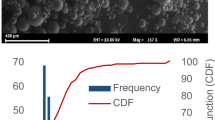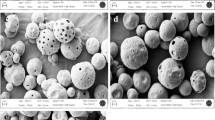Abstract
Purpose. In this study, we developed and evaluated a novel method to produce insulin-loaded hydrophilic microspheres allowing high encapsulation efficiency and the preservation of peptide stability during particle processing. The preparation method used the diffusion of water by an excess of solvent starting from a water-in-solvent emulsion.
Methods. The water dispersed phase containing albumin or lactose, or albumin-lactose in different weight ratios, and insulin was emulsified in water-saturated triacetin with and without emulsifiers, producing a water-in-triacetin emulsion. An excess of triacetin was added to the emulsion so that water could be extracted into the continuous phase, allowing the insulin-loaded microsphere precipitation. Insulin stability within the microspheres after processing was evaluated by reverse-phase and size-exclusion high-performance liquid chromatography.
Results. The water diffusion extraction process provided spherical microparticles of albumin or albumin-lactose. The mean diameter of the microspheres prepared with or without emulsifiers ranged from 2 to 10 μm, and the encapsulation efficiency of insulin was between 60% and 75%, respectively. The analysis of microsphere content after processing showed that insulin did not undergo any chemical modification within microspheres. The use of lactose alone led to the formation of highly viscous droplets that coalesced during the purification step.
Conclusions. The water extraction procedures successfully produced insulin-loaded hydrophilic microspheres allowing the preservation of peptide stability. The type of excipient and the size of the disperse phase of the primary w/o emulsion were crucial determinants of microsphere characteristics.
Similar content being viewed by others
REFERENCES
C. Chemtob, T. Assimacopoulos, and J. C. Chaumeil. Preparation and characteristics of gelatin microspheres. Drug Dev. Ind. Pharm. 14:1359–1374 (1988).
R. Arshady. Albumin microspheres and microcapsules: methodology of manufacturing techniques. J. Control. Rel. 14:111–131 (1990).
G. Chen, W. Lin, A. Coombes, S. S. Davis, and L. Illum. Preparation of human serum albumin microspheres by a novel acetoneheat denaturation method. J. Microencapsulation 11:395–407 (1994).
F. Pavanetto, I. Genta, P. Giunchedi, B. Conti, and U. Conte. Spray dried albumin microspheres for the intra-articular delivery of dexamethasone. J. Microencapsulation 11:445–454 (1994).
H. Sah, M. S. Smith, and R. T. Chern. A novel method of pre-Trotta et al. 1448paring PLGA microcapsules utilizing methylethyl ketone. Pharm. Res. 13:360–367 (1996).
J. C. Leroux, E. Allémann, E. Doelker, and R. Gurny. New approach for the preparation of nanoparticles by an emulsificationdiffusion method. Eur. J. Pharm. Biopharm. 41:14–18 (1995).
M. Trotta, M. Gallarate, F. Pattarino, and S. Morel. Emulsions containing partially water-miscible solvents for the preparation of drug nanosuspensions. J. Control. Rel. 76:119–128 (2001).
M. Trotta, F. Debernardi, and O. Caputo. Preparation of solid lipid nanoparticles by a solvent emulsification-diffusion technique. I nt. J. Pharm. 257:153–160 (2003).
X. M. Zeng, G. R. Martin, and C. Marriott. Preparation and in vitro evaluation of tetrandrine-entrapped albumin microspheres as an inhaled drug delivery system. Eur. J. Pharm. Sci. 3:87–93 (1995).
P. Harjumen, T. Lankinen, H. Salonen, V. P. Lehto, and K. Järvinen. Effects of carriers and storage formulation on the lung deposition of a hydrophobic and hydrophilic drug from a DPI. Int. J. Pharm. 263:151–163 (2003).
W. D. Lougheed, A. M. Albisser, H. M. Martindale, J. C. Chow, and J. R. Clement. Physical stability of insulin formulation. Diabetes 32:424–432 (1983).
U. Grau and C. D. S audek. Stable insulin preparation for implanted pumps. Diabetes 36:1453–1459 (1987).
Y. M. Kwon, M. Baudys, K. Knutson, and S. W. Kim. In situ study of insulin aggregation induced by water-organic solvent interface. Pharm. Res. 18:1754–1759 (2001).
J. Brange. Stability of Insulin, Kluver Academic Publishers, Boston, 1994.
H. Throw and K. Geisen. Stabilization of dissolved proteins against denaturation at hydrophobic interface. Diabetologia 27: 212–218 (1984).
V. Sluzky, J. A. Tamada, A. M. Klibanov, and L. Langer. Kinetics of insulin aggregation in aqueous solutions upon agitation in the presence of hydrophobic surfaces. Proc. Natl. Acad. Sci. USA 88:9377–9381 (1991).
M. Garcìa-Fuentes, D. Torres, and M. J. Alonso. Design of lipid nanoparticles for the oral delivery of hydrophilic macromolecules. Coll. Surf: B: Biointerf. 27:159–168 (2002).
T. Uchida, N. Nagareya, S. Sakakiraba, Y. Konishi, A. Nakai, M. Nishikata, K. Matsuyama, and K. Yoshida. Preparation and characterization of polylactic acid microspheres containing bovine insulin by w/o/w emulsion solvent evaporation method. Chem. Pharm. Bull. 36:1539–1543 (1997).
Author information
Authors and Affiliations
Corresponding author
Rights and permissions
About this article
Cite this article
Trotta, M., Chirio, D., Cavalli, R. et al. Hydrophilic Microspheres from Water-in-Oil Emulsions by the Water Diffusion Technique. Pharm Res 21, 1445–1449 (2004). https://doi.org/10.1023/B:PHAM.0000036919.94865.57
Issue Date:
DOI: https://doi.org/10.1023/B:PHAM.0000036919.94865.57




